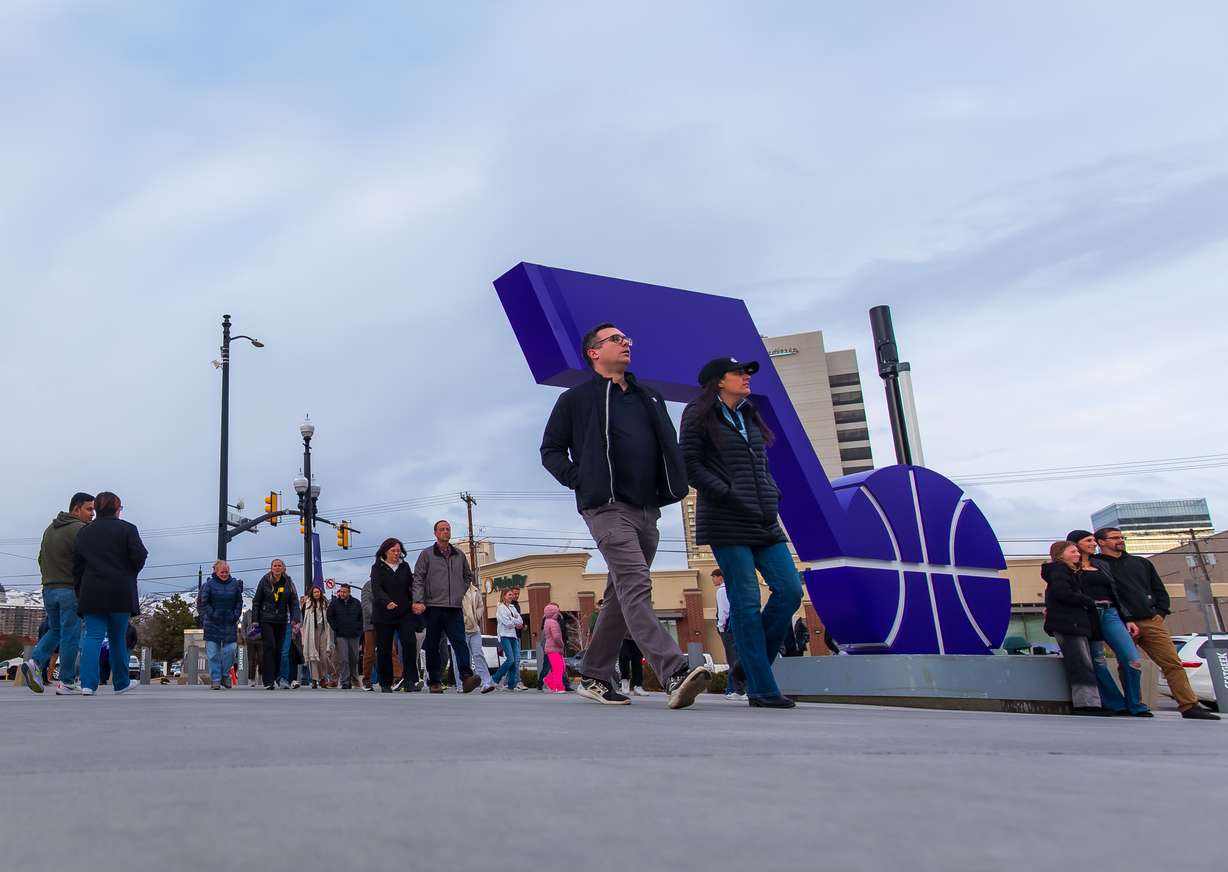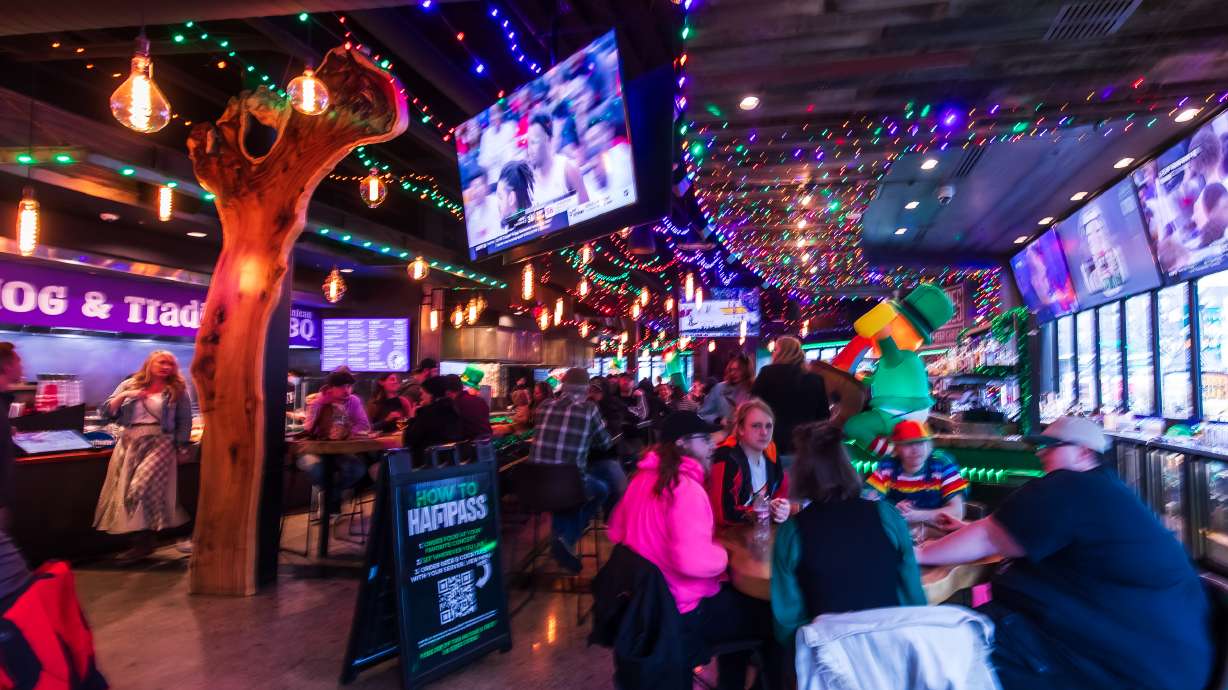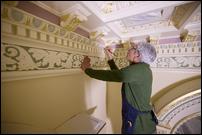Estimated read time: 6-7 minutes
- Salt Lake City's downtown recovery post-COVID shows promising trends in social economy.
- Downtown leaders say the Utah Hockey Club and Temple Square's future reopening can boost future business and tourism.
- Upcoming 2034 Winter Olympics and planned infrastructure projects could also drive future economic growth.
Editor's note: This is part two of a two-part series reviewing how downtown Salt Lake City drastically changed five years after the COVID-19 pandemic began. Read part one here.
SALT LAKE CITY — Mia Patmides is sitting at a table at HallPass while building staff and employees of various restaurants inside the food hall feverishly prepare for what figures to be a busy day ahead.
The building's interior is filled with trendy LED lights and St. Patrick's Day decorations ahead of the holiday, keeping up with the type of aesthetics that attract patrons. Fridays and weekends, she says, are often busy, but it helps that the Utah Jazz are also slated to play that evening.
"We get a lot of business from Delta Center, so we try to stay open later than we (do)," she said. "People like to come in and hang out (and) have a few drinks right after."
Sure enough, the food hall is packed an hour before tipoff. Salt Lake City's social economy, including bars and restaurants, as well as sporting events, concerts, plays, conventions and other special events, has kept downtown Salt Lake City active since the COVID-19 pandemic, while its workforce population has yet to fully recover.
Patmides, who also owns a pair of restaurants inside HallPass, said social media has been huge for eateries to attract new customers since the pandemic. Downtown's residential growth has also helped boost bars, restaurants and retailers after traditional work hours, adds Dee Brewer, executive director of the Salt Lake City Downtown Alliance.
Even though total visitation last year remained about 20% below pre-pandemic levels, downtown businesses and business leaders say they're ready for major events and other large changes that could get downtown over the hump.
Adding to Salt Lake visits
The Utah Hockey Club, which started playing in October, has already added to Salt Lake City's downtown visitation. HallPass reported last month that business has been up 15% since then, while Flanker leadership has also found hockey to exceed expectations.

Then there's Temple Square, a few blocks northeast of the arena. On top of COVID-19, the Salt Lake Temple and many other aspects of the grounds that drew 3 million to 5 million visitors annually, have been closed due to construction. The temple will finally reopen with a six-month open house in 2027, which is expected to bring millions of visitors downtown and spur an economic impact of over $320 million.
More housing is expected to be built in downtown Salt Lake City over the next decade, as it quickly becomes residential once again. Expansion in nearby areas like the Granary and Rio Grande districts, as well as Ballpark, Central City and Fairpark could also help bring people downtown.
Related:
It's also too early to write off Salt Lake City's downtown business recovery.
Federal workers have started coming back to in-person work in recent weeks, many for the first time since the pandemic, according to the Associated Press. Salt Lake City is home to multiple federal office buildings, although at least one downtown location that has historically brought in over 600 federal employees could be on the chopping block as the Trump administration looks to sell off "noncore" properties.
Bloomberg also reported earlier this month that investment bank giant Goldman Sachs is seeking to bring more of its employees to Salt Lake City. It's unclear how many people that would attract, but it could tack onto numbers.
(Salt Lake City is) a place where tenants want to be, companies can grow and I see that as a standout compared to other markets.
–Tim Helgeson, senior vice president of asset management for KBS
And with tech companies now itching to get back to in-person work, as well, Tim Helgeson, senior vice president of asset management for the commercial real estate company KBS, expects the data will start "turning the corner" soon.
Helgeson is "bullish" about Salt Lake City's future for many reasons. He oversees four Utah buildings that the company owns, as well as buildings near Denver, Phoenix and Los Angeles. That's helped him to see how Salt Lake City has outperformed others in recent years, joking that others rib him for how often he talks about it.
Utah continues to have one of the strongest economies in the U.S., and its universities are producing "high-quality" students. While housing is starting to get expensive, it's still cheaper in and around Salt Lake City than many other big cities. Salt Lake City also offers a "work-play" environment that makes it intriguing for young employees, and it has a fast-growing airport along with other major "infrastructure investment."
"(All of it) has helped highlight Salt Lake City through the pandemic, where it's kind of been a shining light," he said. "It's a place where tenants want to be, companies can grow, and I see that as a standout compared to other markets."
Salt Lake's future?
Big changes are also on the horizon as Salt Lake City prepares to host the 2034 Winter Olympics, which itself can boost the city's publicity.
One of the biggest changes would be a complete remodel of the area surrounding the Delta Center, which is also expected to undergo a remodel as early as this year. Utah lawmakers approved a bill during this year's general session that helps Salt Lake County fund a massive overhaul of the Salt Palace Convention Center, potentially doubling its future revenues.
All of this is to say Salt Lake City is on the cusp of looking completely different. Patmides expects that downtown will be a larger mix of residents, workers and visitors if and when everything is implemented, drawing back some of the city's missing crowds, like office workers and lunchtime crowds.
"I think it's going to create a synergy if anything," said Julissa Breslin, marketing director at the Gateway Mall, adding that the Gateway and others are eagerly awaiting for the Delta Center plans to be finalized.
COVID-19 may have nudged those trends early, but Brewer believes downtown was already on a trajectory for that type of future. He thinks the pandemic's biggest impact — to this point — might be the changes to workplace options that took place, but downtown was going to be a residential magnet again because of shifting trends in household sizes, young professional preferences and housing needs.
"I think we were headed there, pandemic or not," he said,











